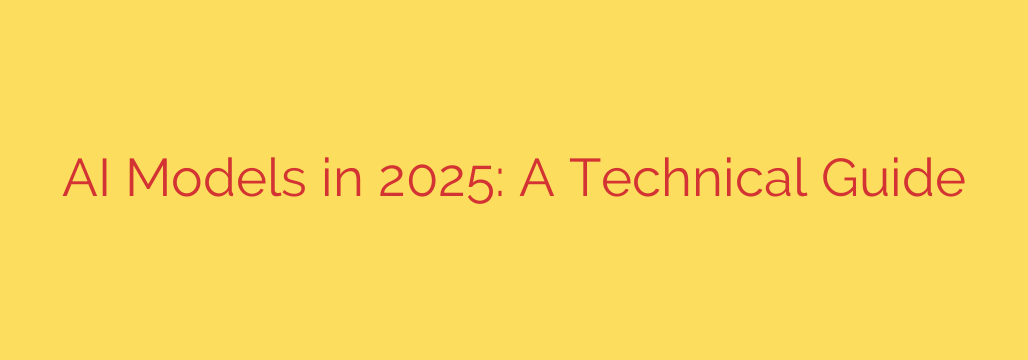
The AI Revolution in 2025: Key Trends Shaping Our Digital Future
Artificial intelligence is evolving at a breathtaking pace, moving from a niche technology to a fundamental part of our digital lives. As we look toward 2025, the landscape of AI models is set for a dramatic transformation. We’re moving beyond simple text-based chatbots into a new era of more integrated, efficient, and autonomous systems.
Understanding these shifts is crucial for business leaders, developers, and curious enthusiasts alike. Here are the key technical trends that will define the most advanced AI models in 2025.
1. The Rise of True Multimodality
The next generation of AI will not be limited to just text or images. Instead, the defining feature of leading models in 2025 will be true multimodality. This means AI will be able to seamlessly understand, process, and generate content across various formats—including text, images, audio, video, and even code—all within a single, unified system.
Imagine an AI that can watch a video tutorial, listen to your verbal questions about it, write the necessary code, and create a summary graphic. This holistic understanding allows for a much richer and more contextual interaction. For businesses, this translates to more sophisticated applications, from hyper-personalized marketing campaigns that analyze video feedback to advanced diagnostic tools in healthcare that can interpret both medical scans and a doctor’s spoken notes simultaneously.
Key takeaway: AI will move from specialized, single-task models to all-in-one cognitive systems that perceive the digital world more like humans do—through multiple senses at once.
2. Efficiency is King: The Shift to Specialized and Smaller Models
While massive, general-purpose Large Language Models (LLMs) have dominated headlines, 2025 will see a major push toward efficiency. The immense computational cost and energy consumption of training and running giant models are unsustainable for many applications.
In response, two trends are emerging:
- Mixture-of-Experts (MoE): Instead of one massive neural network handling every query, MoE architecture uses a collection of smaller, specialized “expert” models. When a query comes in, a router system directs it to the most relevant expert or combination of experts. This is far more efficient, as only a fraction of the total model is used for any given task, leading to faster response times and lower operational costs.
- Small Language Models (SLMs): For specific tasks, a highly trained SLM can often outperform a generalized LLM. These compact models are designed for excellence in a narrow domain, such as customer service contract analysis or medical transcription. Their smaller size makes them cheaper to run and ideal for deployment on local devices.
3. AI in Your Pocket: The On-Device Revolution
The drive for efficiency directly enables another massive trend: on-device AI. Instead of sending your data to a remote cloud server for processing, more AI tasks will be handled directly on your smartphone, laptop, or even in your car.
This shift has profound implications for users and developers:
- Enhanced Privacy: Your personal data stays on your device, significantly reducing privacy risks associated with sending sensitive information to third-party servers.
- Instantaneous Speed: With no network latency, on-device AI can perform tasks like real-time language translation or photo enhancement almost instantly.
- Offline Functionality: Critical AI-powered features will work even without an internet connection, making applications more reliable and accessible.
Expect to see smarter, more responsive, and more private AI assistants integrated directly into the operating systems of the devices you use every day.
4. From Assistants to Agents: The Dawn of Autonomous AI
Perhaps the most exciting leap forward will be the transition from reactive AI assistants to proactive, autonomous AI agents. Today’s AI primarily responds to direct commands. An AI agent, however, can take a complex goal and independently execute a multi-step plan to achieve it.
For example, instead of asking an AI to “find flights to New York,” you could instruct an AI agent to “plan my entire business trip to New York for next week’s conference.” The agent would then:
- Check your calendar for availability.
- Find and compare flights that fit your schedule and budget.
- Book a hotel near the conference venue.
- Arrange ground transportation.
- Add all confirmations and itineraries to your calendar.
This level of autonomous task execution represents a fundamental change in how we interact with technology, turning AI from a tool you operate into a delegate that works on your behalf.
Navigating the Future: AI Security and Ethics
As AI models become more capable and autonomous, the importance of security and ethical alignment grows exponentially. The challenges of 2025 will include combating sophisticated deepfakes, preventing AI-driven misinformation, and securing models from data poisoning attacks.
In response, the field of AI safety is rapidly advancing. Expect to see more robust techniques for digital watermarking to identify AI-generated content, as well as more sophisticated alignment strategies to ensure that autonomous agents operate within safe and ethical boundaries.
Actionable Security Tips for the AI-Powered Future
- Practice Healthy Skepticism: As AI-generated content becomes indistinguishable from human-created content, always seek to verify critical information from trusted, primary sources.
- Manage Your Data Footprint: Be mindful of the permissions you grant to AI applications, especially those that operate on-device and have access to your personal data.
- Look for Transparency: Favor companies and developers who are transparent about their use of AI, their data policies, and the steps they take to ensure ethical alignment.
The road to 2025 is paved with innovation. By focusing on multimodality, efficiency, on-device processing, and true autonomy, the next generation of AI promises to be more powerful, personal, and integrated into our world than ever before. Preparing for this future starts with understanding the technology that will drive it.
Source: https://collabnix.com/the-complete-guide-to-ai-models-in-2025-a-technical-deep-dive-into-the-ai-revolution/







